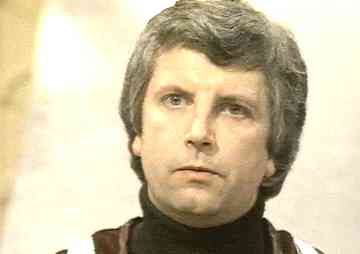
|
Administrator on research station XK-72. He was willing to let Avon join the
station's personnel incognito, and criticised Kayn for informing the
Federation of Liberator's presence. Kayn then strangled Farren to
death in a fit of rage moments before the station was destroyed.
|  |
To catalogue every item of clothing seen in the series would be somewhat impractical, but certain particular styles appeared more than once, particularly in the 1st Season. Most of the people on Earth in The Way Back wore sleeveless, collarless, "tabard"-like garments in a variety of colours. Many jackets in later episodes had elbow-length or shorter sleeves, as did some of Servalan's gowns in, for example, Seek-Locate-Destroy. Both Jenna and Cally were seen wearing outfits with "petalled" shoulders. Shirts were either stud or button-fastened with a variety of collar types - Federation personnel exhibited some preference for tight vertical collars. Tarrant, in the 3rd Season, showed a liking for short-sleeved quilted hauberks. Knee-length boots were worn by virtually every regular character at some time or other, though this probably reflects practicality as much as anything else. Hats were a rarity, worn only by Servalan in Pressure Point, Travis and Docholli in Gambit. Servalan and Travis wore simple wide-brimmed pieces, white and black respectively, Docholli's was more "Western" in style. Each member of the 1st Season crew had his/her own two-tone surface parka.
The origin of Liberator's capacious wardrobe (it supplied more than a hundred different outfits over 38 episodes) was never discussed, nor how closely the contents correlated with everyday styles of dress. The series does, however, apparently offer hope to those who believe that flares really will make a comeback someday.
See the Costumes Index for detailed info about all of the clothing worn by the crew.
The term is said in the conversation between Travis and the base commander. The Liberator raced in and then raced out. The base commander assumed that Blake had scanned the terrain for reconnaissance and/or surveillance before making the real assault.
Diagnosed by Cally as affecting the crew of Liberator, citing Blake's headaches, Vila's stomach cramps and Avon's back pains as arising from the condition, caused by "too many crises...too many calls on our physical and mental reserves". She prescribed complete rest, so Blake promptly started following a Federation freighter.
The description and possible title of the worlds under the direct control of the Federation. In Space Fall, Vila said that when it came to computers, Avon was 'the number two man in all the Federated worlds'; and in Shadow, Blake said that the Terra Nostra worked in secret on 'Earth and the Federated worlds'.
See also FEDERATION.
An oppressive dictatorial regime with varying control over an unspecified portion of the colonised galaxy. Fan lore often refers to the events in the series taking place in "the third century of the Second Calendar", but there is no canonical support for this. In Pressure Point Blake referred to the Federation starting to expand 200 years before his attack on Control. In the same episode he told Gan of the Federation destroying all churches at the start of the New Calendar. Reference to an "Old Calendar" was made in Countdown. It is tempting to place the Federation's origins with the early years of the New Calendar, but there is no conclusive evidence to support this, and the two probably do not coincide - the date before which Blake allegedly molested Carl Deca, Renor Leesal and Payter Fen is shown in The Way Back as 52.6.8, suggesting that the New Calendar year is probably either 152 or 252. If the New Calendar was introduced by the Federation after its expansion from Earth, it is 52 or 152, if before then 252 (or even 352, 452 etc). This of course assumes that the dates given in The Way Back are conventional ones and not in some notation peculiar to Blake's era.
Generally referred to simply as "the Federation", but called the "Terran Federation" on a number of occasions: in The Way Back Blake's trial was held by the authority of the Terran Federation; in Duel Travis described himself to Sinofar and Giroc as a representative of the Earth Federation; and in Voice from the Past Ven Glynd claimed he had enough information to convict the Terran Federation and Space Command. Servalan referred to herself as "President and Supreme Commander of the Terran Federation in Powerplay, The Harvest of Kairos and Moloch.
The population on Earth was shown to be dosed with suppressants, but such measures were not seen again until Commissioner Sleer initiated her Pacification Programme in the 4th Season. Various sanctioned atrocities were referred to: Hal Mellanby's supporters were wiped out after their surrender, half the population of Saurian Major was butchered, and the same fate may well have befallen the people of Agrava if a series of accidental explosions had not occurred. The dissidents at Bran Foster's meeting in The Way Back were massacred despite offering no resistance to the security forces, and dissidents from Blake's earlier revolutionary period were executed. Slavery was referred to a number of times, with Rashel being a "bond-slave", mention made of Maryatt's family becoming slaves after his "desertion" and Servalan's threat to send Travis to "the slave pits of Ursa Prime". Non-Terran peoples were used as slave labour on UP-Project Avalon and Horizon. Annexation of new colonies was shown to be by dubious means in Blake's description of the Lindor Strategy. Once annexed, planets could be retained by outright terrorism, as with the solium radiation device on Albian. Corruption within the judicial system ran to the highest level, as witnessed in Blake's second trial, supposedly for indecently assaulting children (although Arbiter General Ven Glynd later hinted he was planning his defection at or before this time). The President himself supervised the production and distribution of the fatally addictive drug shadow.
This should not be confused with the actions of individuals: Travis was responsible for at least one massacre of unarmed civilians, but this was a recognised war crime for which he eventually came to be sentenced to death, albeit for Servalan's convenience. Many of Servalan's actions were more those of an ambitious power-seeker rather than an instrument of a ruthless establishment.
The few references to law and punishment indicated a harsh attitude. Churches were destroyed at the start of the New Calendar, strongly implying but not explicitly stating an ongoing suppression of all religious practice. Going outside the dome city on Earth was a Category-4 crime (the Arbiter at Blake's trial described his offences as Category-9 and "most grave"), and contact with "outsiders" was illegal. Failure to register a change of address resulted in a fine, if only a small one, as noted by Servalan in Aftermath. Vila mentioned the banning of leisure transport in Stardrive - this may have been at the same time as the banning of space choppers "a couple of centuries back". The prisoners deported to Cygnus Alpha were convicted of child molesting (Blake, falsely), embezzlement (Avon), murder (Gan), smuggling (Jenna) and irremediable compulsive stealing (Vila).
The extent of the Federation is hard to gauge. Many planets were neutral, as were larger systems (such as Teal and Vandor), but no major power blocks on a par with the Federation in size were ever referred to. Servalan observed that the destruction of Star One left "half the civilised worlds" to their fate, a possible indication of the Federation's pre-war size. The President was, amongst other things, "Lord of the Inner and Outer Worlds", but little elaboration was given to these titles.
Rule was by a President and High Council, though a senate apparently also played some part in the Federation's power structure. Before the Intergalactic War an uneasy balance of power appeared to lay between the Administration and Space Command, the military wing. In theory the former controlled the latter, but Par asserted that "Space Command runs the Federation". Servalan was several times seen to be pressured by civilian political figures, particularly Secretary Rontane and Councillor Bercol in Seek-Locate-Destroy and Councillor Joban in Hostage - such instances call Par's claim into question.
Immediately prior to the War, Servalan seized control in what appeared to be a relatively effortless coup and became President and Supreme Commander of the Terran Federation. Practor later referred to her as "the Supreme Empress": this may have been facetiousness on his part, but Practor did not come across as a facetious person. If, as one of the stranded troopers on Sarran said, 80% of the Federation's space fleet had been destroyed, then Servalan's power must have been tenuous in the beginning, and as late as Moloch Grose said her reconstituted Federation wasn't "worth a light". In Rumours of Death Chesku talked of "Earth and the Inner Planets" being reunited, but there is no indication as to how much of the pre-War Federation this represented.
In the early aftermath of the War the Federation may have effectively ceased to exist. "There isn't a Federation anymore" said Tarrant in The Harvest of Kairos, and as late as Children of Auron Servalan could still point to "general disunity and anarchy". In Traitor, Practor mentioned "a great deal of confusion when the High Council was restored to power", adding that most of "the old guard" stayed loyal to Servalan to the end. This is almost certainly a reference to the time when she was deposed from the Presidency, probably during her absence on Terminal. Over time, however, the Federation clearly recovered and regained much if not all of its lost territory, most notably through Commissioner Sleer's Pacification Programme. Avon noted as late as Warlord that the Federation still lacked the military strength for conventional armed conquest.
Kasabi said that "the Federation is degenerate, run by creatures like her [Servalan]", and there was no indication of things improving in this respect after the War.
The Federation's slogan appeared to be "From Strength to Unity", since Servalan signed off from her conversation with LeGrand with these words.
See also ADMINISTRATION, HIGH COUNCIL, PRESIDENT, SPACE COMMAND.
An institution which Tynus threatened to report Dr. Bellfriar to, over the latter's failure to deal with the epidemic-causing alien virus on Fosforon. The title and threat suggest that the institution is similar to the United Kingdom's General Medical Council.
The latter licences doctors to practice medicine in the UK, and is given four main powers by law. First, to keep up to date registers of qualified doctors; second, to foster good medical practice; third, to promote high standards of medical education; and fourth, to deal with doctors whose fitness to practice is in doubt. Presumably, the Federation Medical Council had similar powers regarding doctors in the Terran Federation as Tynus threatened to invoke its investigative and disciplinary power.
In Ultraworld, the Ultra noted that Tarrant was a graduate of the Federation Space Academy.
In Moloch, Servalan told Grose and Lector that a graduate of the "Space Academy" needed five years before he (sic) could "even begin to acquire the basic skills and experience necessary to pilot an advanced star cruiser."
An energy-focussing crystal, its action analogous to a burning glass, but "infinitely" more efficient. Exactly how feldon worked, however, was (perhaps wisely) not entered into at length. The "hardest known substance in the universe", it was extremely rare, Orac mentioning traces in the asteroid belt (presumably of the Solar System) and "a few insignificant planets". The Federation was prepared to start major mining operations on planets previously considered uninhabitable to get it. Mining operations had been in progress on Mecron II for twelve years, but this apparently began before the Federation appreciated the true potential of feldon: a series of uncontrolled accidental explosions on Agrava, killing thousands of people, prompted full-scale investment. On Mecron II at least, extraction of feldon was by electromagnetic crusher: everything but the feldon was reduced to a fine dust, leaving the crystals readily removable.
Feldon was of course not only rare and useful but valuable as well, and the consignment Belkov had supposedly stored away over his twelve years on Mecron II had an estimated value of between 900 million and a billion credits. The Mecronian priests considered feldon to be a symbol of power, and one priest died whilst wearing a necklace of crystals during a lightning storm. Belkov exploited this incident to prove he had been sent by the gods to mine the crystals. His ship Orbiter was fitted with feldon panels, which could harness the energy of distant stars to control its movements.
See also JEWELS
| One of the Clonemasters, and herself a clone. She created at least two clones of Blake for Servalan. | 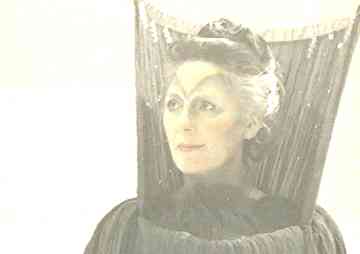 |
| Along with Carl Deca and Renor Leesal, one of three children treated to believe he (or possibly she) had been assaulted by Blake. Fen's date of birth was given as 43.2.1, a patient of Dr Wen Caen, and s/he attended school ZL 3 Level 417. | 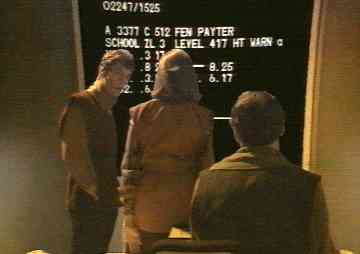 |
Sarkoff played a (very scratchy) recording of her Blow the Wind Southerly in his residence. Blake destroyed it to persuade Sarkoff to leave the planet with him.
Born in 1912, Kathleen Ferrier first established her reputation as a contralto in the Second World War, singing for factories and the forces. She remained popular after the war, until illness forced her early retirement in 1953, in which year she later died.
Fibre optics were mentioned just once: when Dr Plaxton offered to install her Mark II photonic drive in Scorpio, she checked with Tarrant that the current plasma drive was linked to the ship's controls by standard fibre-optic connections.
Phenomenon twice mentioned by Jenna and apparently related to gravitational influences on a space craft. In The Web the gravitational attraction of UP-The Web on the Liberator had a "field strength" of 3.5, which Jenna said was too big for field drag. In Mission to Destiny she stated that field drag whilst passing through a meteor storm was forcing her to use more power to maintain speed.
Federation unit, all but wiped out in the Intergalactic War. The survivors under Colonel Astrid accidentally landed on Sardos, and took command of the population there. Grose later deposed Astrid and assumed personal control. Servalan noted that the Fifth Legion was renowned for "women, food and inflicting pain - in no particular order".
Fitted to the Ortega and no doubt most if not all other space craft. The filtration, or filter, plant handled the recycling of air aboard the ship and controlled oxygen levels. Sara put the crew of the Ortega to sleep with a canister of sono vapour, rigged to bypass the filter mechanism.
Name used to refer to space, according to a public viscast, presumably by the inhabitants of a world before deep space travel became commonplace. It may have originally become popular on Earth due to its use in Star Trek, a science-fiction television series of the twentieth and twenty-first centuries AD.
| A lieutenant of Zukan, who journeyed with him to Xenon. He assisted Zukan by planting explosives around the base, sealing off all the exits, and informed Zukan that Zeeona was present on the base. He noticed the bomb that Servalan had planted on Zukan's ship, and was ejected into space by Zukan whilst trying to remove it. | 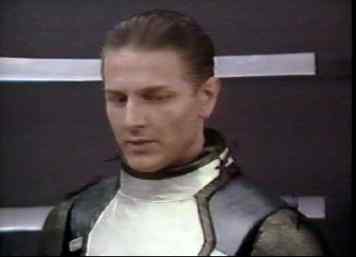 |
Prayer of the religion founded on Cygnus Alpha. It runs:
Only from His hand comes life
And from His hand comes death
We obey Him and give thanks for His mercy.
He is the giver of salvation
His power drives out the ravening beast that is death
It is He who must be obeyed.
Recited by Vargas, and echoed by Kara who ended with the words "We thank You".
Possible expletive, used by a Space Rat: "We're only moving the flagging shield."
Servalan addressed her distress calls from Sarran to Fleet Command.
Mentioned by Servalan when news of the alien attack force reached her headquarters. She told Durkim to "patch this office into the fleet co-ordination suite".
The General on Helotrix told Colonel Quute about the ill-fated Fletch expedition of "29, who used gas against the Waazis without realising their capacity to lay dormant for days. The whole expedition was wiped out over dinner.
Fletch was presumably the commander of this force, and was probably a Federation officer.
Part of the Liberator's battle computers, it apparently predicted the flight of Liberator itself rather than potential targets, although it may have been able to do both.
Several references in The Web to "theoretical navigation" might be taken as further indication of the flight predictor's function.
During its journey to Terminal, the Liberator encountered a large number of minute fluid particles grouped in what was variously called a broad spread, a band, a cloud, and a matter belt. These particles had a high level of energy, and Zen later suggested that they contained an unidentified enzyme.
|
Due to an uncountermandable order of Avon's, the Liberator went through
the fluid particles, which adhered to the hull, after knocking out the
latter's sensors. There followed unidentified enzyme activity resulting in
molecular metamorphosis. A substance was produced that, in Vila's words,
was '...eating into everything! Metal, plastics, fibres, just rotting away'.
| 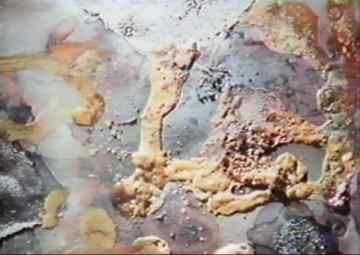 |
By the time that Vila ordered the closedown of the auto-repair systems and Zen to make an all out investigation, dangerous structural weaknesses had developed in many areas. The dysfunction of at least five of Zen's computer banks led to loss of power and computing ability. The Liberator was finally destroyed after Servalan captured it, when she ordered the activation of the main drive, the stress of propulsion proving too much for its dangerously weak structure.
In the context of the series, the fluid particles are of particular interest due to their destruction of the Liberator, allied to their mysterious nature.
See LIBERATOR.
Form of power cell (presumably flutonic). The Lost used them to power Saymon's life support system, and hence maintain Geela and Novara. They summoned Liberator to their planet, using Cally as their agent, when power began to run low, and requested new cells from Blake. He replied that Liberator might not have exactly the same type of cell (he recognised them for what they were) but might have something that could be adapted - despite the fact that the Lost had been in exile for an unspecified but long period of time (Cally referred to them as a "legend"). Of course, the Lost might have acquired their old cells relatively recently from an unspecified source.
| The light aircraft used by Blake (amongst others) on Gauda Prime. See VEHICLES for further details. | 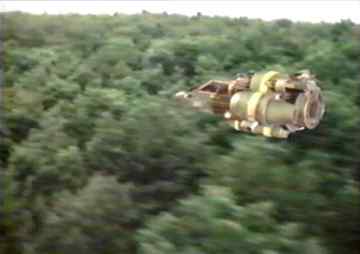 |
Part of Scorpio's main drive, damaged on collision with an asteroid whilst trying to enter the Altern system.
Numerous references throughout the series. They include:
| Drinks featured in many episodes, though were rarely named. Most were coloured, usually green but sometimes blue, white or even yellow, and some were definitely alcoholic. | 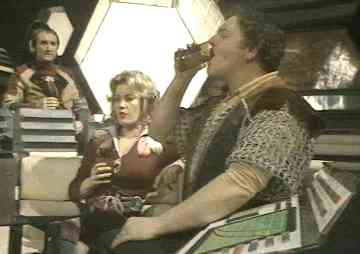 In Mission to Destiny |
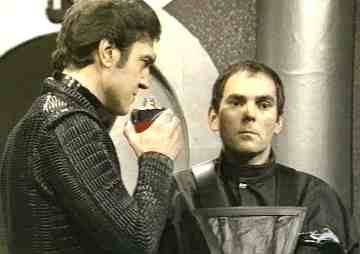 Travis and Par | Par offered Travis a flask of liquor which he described as "good stuff". Travis ordered a Vitazade in Freedom City, and adrenalin and soma was mentioned in Horizon, Volcano and Animals. Wine was certainly available on Goth and Sardos and Dorian kept a locker full of quality wine. Vila suggested breaking out the booze and mentioned wine in Death-watch. More precise details are, however, lacking. |
An attendant at the court of the Charl of Goth. Gola's Fool had been hypnotically given the coordinates of Star One, and released them on hearing the trigger phrase "A Fool knows everything and nothing". Sent to the dungeons by Gola, he remained there with his master, Gola's deposed father, when Blake left.
The position of Fool was temporarily filled by Vila.
| Defence area around the entrance to Central Control on Earth, with hidden surveillance cameras and a lethal, high intensity radiation grid covering an area about 50 yards around the bunker entrance. The grid could apparently root people to the spot, preventing their escape, and was self-repairing in eight seconds. | 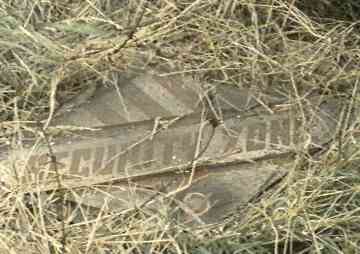 |
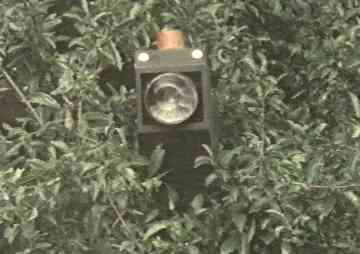 | Avon supposed that the bunker might also be fitted with antimatter screening. Arle and Berg died in the Forbidden Zone after stepping on the grid; Blake, Avon, Vila and Gan blasted a way through. Servalan used her authority to have the grid deactivated, allowing Travis and two mutoids access to the bunker. She later followed herself, held at gunpoint by Jenna and Veron. |
Inventor of Pylene-50, and keeper of the formula. Servalan kept him working for her by poisoning him with tincture of pyrhennic, an extract of pamperanian fungi, but eventually killed him after he tried to kill himself and her with his "primitive nitroglycerine". Forbus also developed an antidote to Pylene-50, which he gave to Tarrant and Dayna, and it was he who led them to realise that Leitz was a traitor.
Like a number of people encountered by the crew, Forbus had heard of the Liberator and also knew of Dayna and Tarrant by name.
A number of force fields - called by various names - were encountered in seventeen episodes. They consisted of two types: those that protected planets or planetary installations, and those that protected spaceships. Those of the former type appeared in the following six episodes:
In Orac, Ensor's hideaway was protacted by a 'surface force barrier' (Servalan), which forced Servalan and Travis to go under it to get there, via the tunnels under the old city. Once disconnected, the 'force barrier' (Blake) took five hours to dissipate. Also, signal transmissions through the 'energy screen' (Orac) were not possible.
In Voice from the Past, 'security force walls' were present around Atlay as part of the security arrangements for the governors' conference.
In Star One, the computer complex was 'shielded', making it impossible for Vila to teleport Blake and Cally once they were inside.
In City at the Edge of the World, two of the most sophisticated force fields in the series were encountered. The first protected a vault in a city on Kezarn. It was designed to refract light, giving the appearance of a door. This afforded the vault extra protection, as those before Vila incorrectly assumed that it was a solid object. He found that the force field's energy threshold was 002; so he set up a low energy probe to push a probe into the force field at a maximum energy of 001, correctly predicting that this would cause the latter's collapse.
Vila and Kerril encountered the second force field aboard a starship, protecting an exit. While designed by the same person, it was slightly different, refracting light at the same frequency as the wall, rendering it invisible, ensuring that those on board the ship did nothing rash, like attacking the weakest point in the wall.
This episode is of interest due to the remarks made by Vila to Kerril about the nature of force fields in general. First, he explained that all force fields feel solid; the designer in the case of the first force field simply used the refraction of light to also give the appearance of a solid object.
Second, he explained why the methods previously used to break through failed, because 'like all force fields, whatever energy you push into it, it chucks right back at you. For all energy input, there has to be an equal and opposite energy output. Result - an indestructible block'. Lastly, he was able to figure out that some kind of exit from the starship existed, protected by a force field, as 'Air can bleed through a force field'.
In Headhunter, Muller told Tarrant that direct teleportation into his laboratory was possible, as it was not 'shielded'.
In Games, Belkov claimed that by using the Feldon crystals on Orbiter and reflectors on the moon, he could set up 'a series of force fields' to keep Scorpio from leaving Mecron 2's orbit; but this described what Avon correctly identified as 'Multiple traction beams'.
Of the force fields used to protect spaceships, the one most frequently used in the series was that which protected the Liberator - called the 'force wall' - used in nine episodes. Notable uses were as follows:
Mission to Destiny: The force wall was first mentioned in this episode, when a meteorite storm was encountered. Questioned as to whether the force wall would hold, Zen replied that the storm was within the 'maximum design tolerance' but with 'no safety margin', being unable to say if there was sufficient reserve power to maintain the wall. At about halfway through the storm, Gan remarked that the force wall was eating into the ship's power reserves. Zen them warned that in 1.03 minutes it would be impossible to operate the force wall and main drive simultaneously, Blake then deciding to deactivate the former.
Duel: The forcewall was first used in combat in this episode. When the first Federation plasma bolt was launched, Jenna ordered the force wall's activation; but Blake countermanded this, saying that it was 'too much of an energy drain'; and he ordered its activation only a short time before the bolt struck. After it hit, he ordered the wall's deactivation. This went on for eight more bolts, till Blake decided to ram Travis's ship. Gan wondered if the force wall could withstand a salvo of four plasma bolts, which were fired; but the question was rendered academic due to the intervention of Sinofar and Giroc.
Horizon: The force wall ensured that the Liberator was not destroyed by the Federation's magnetic barrier protecting Horizon.
Hostage: When facing a surprise second Federation attack, by twenty ships, Blake ordered 'Activate force wall 360'. He also asked if the power reserves were switched in, Jenna confirming that they were.
Dawn of the Gods: Avon ordered Zen to activate the force wall when the latter identified a dust cloud of intensity 6 in the ship's flight path, Tarrant remarking that they couldn't afford a drain on the energy banks. Later, Zen predicted that the force wall's collapse was imminent, as the Liberator's velocity was 'in excess of design limitations', which soon happened, damaging the outer teleport transducers.
The Harvest of Kairos: In this episode, two interesting properties of the Liberator's force wall were revealed. First, the ship could attack through its force wall, Servalan's remark that this was 'absurd' revealing that other spaceship force fields didn't have this ability. Also, the force wall could be brought to 'maximum deflection' on either 'interlock' or 'overlap'. Dayna's inability to do 'overlap' ensured that the Liberator's keel section was damaged.
A few conclusions can be suggested about this particular force wall. First, it only reduced the amount of damage inflicted on the Liberator, which , as particularly shown in Hostage and Volcano, could be considerable. It therefore must have operated on a different principle to the force fields described by Vila in City. Second, its use was a heavy drain on the ship's energy banks; so only sections must have been activated to conserve power, as the full force wall seemed to only be activated against all out attacks, like in Hostage. Third, it could be activated and deactivated either by Zen or by members of the crew, although it would have presumably been more efficient to use the former.
At least some other ships, particularly Federation, also had force fields for protection. The pursuit ships in Duel had such a force field, a mutoid commenting that if Pursuit Three continued firing, 'it won't have enough reserve to put up its defence shield'. Like the Liberator's force wall, such a force fleld appeared to be a heavy drain on the ship's energy banks. In Children of Auron, Pilot 4-0 was told by Servalan that her ship had also hit a 'random ionic reef' but with its 'force shields up'.
In Stardrive, Scorpio collided with an asteroid, resulting in the need to repair the main drive's focusing core; but the main drive chamber was not pressurised, and the repair too delicate to perform in spacesuits. Vila said that when he was first sent to a penal colony at 14, his ship was hit in the main drive by a meteoroid; and the repair was effected by activating the ship's force wall, and generating an atmosphere inside, so the repair team could work in a vacuun without spacesuits. Slave was able to manage a 'small force wall', a 'blister force wall', around the damaged part of Scorpio's hull, enabling the repair to be carried out.
See FORCE FIELDS.
| Section Leader working with Major Grenlee in seeing to security around Residence 1 on Earth. A popular saying from where he came from (possibly another planet) was "Some days are better than others", and he claimed that his mother cried the day he left home because he "owed her money". He was killed by Sula's rebels when they broke into the residence. | 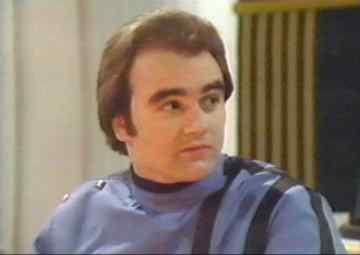 |
Severed by Cally whilst under the influence of the Lost, leaving Liberator blind and forcing Zen to turn to theoretical projection for navigation. Cally's sabotage was carried out in the teleport area.
|
The Federation maintained a Q-base on Fosforon, and Blake visited the planet
to acquire a TP crystal. Blake's comments about Wanderer K47 suggest
that the planet was within 3,000 light years of Earth. The high oxygen
content of the atmosphere made fire a particular hazard on the base. A
plague designed to kill any human who had suffered the Terran Ague broke
loose on Fosforon and killed everyone there. Blake put out a plague warning
transmitter, despite Servalan's imminent arrival.
| 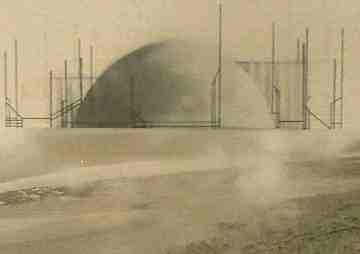 |
| Resistance leader who had known Blake four years previously prior to his arrest and trial. At this time he had presumably been working on Earth, but Richie mentioned that he had recently been on Ziegler-5. Blake did not recognise him when they next met. Foster told Blake some details of his past, opening up some of the sealed off areas in Blake's mind. Despite insisting on not resorting to violence or resisting arrest, he was shot dead by the security forces (the first person at the illegal meeting to be killed). | 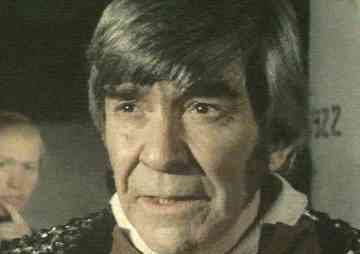 |
[1] Pioneer of cloning and spontaneous cell differentiation on Auron, and an opponent of Auron's isolationist policy. Ginka referred to him having died "several years ago".
[2] Daughter of the above, who continued with her father's work. She was born naturally, before the replication process was perfected, and was thus presumably not telepathic. In charge of the replication plant at the time of Avon's visit, it was Franton who persuaded CA 1 that Zelda should contact Cally aboard the Liberator to seek help against Servalan's plague. She contracted the plague herself, but was cured on Servalan's ship (the first person to be cured of the plague). Having rescued Avon, Cally and Tarrant from Servalan's guards in the control centre. she left Auron with Patar and gene stocks for 5,000 offspring, and presumably arrived safely at the planet Kahn.
Described by Servalan as a "pestilential rathole", Freedom City was situated on a planet not far from the Federation's borders. It was famous for its gambling opportunities including the Big Wheel, and Avon said that "Space City pales by comparison". The planet had a breathable atmosphere, and was home to a species of reptile from the distilled venom of which pataki cakes were made. Chenie referred to Freedom City being run by Krantor. Blake went there in search of Docholli, as did Servalan and, independently, Travis.
Outlawed political party of which Blake was a member. He renounced it after his trial, under the influence of psychological treatments. According to Orac in Voice from the Past, the Freedom Party was founded by Blake himself.
In Shadow Clonemaster Fen pronounced Servalan's name with a French accent. In Voice from the Past, the bogus Shivan described Ven Glynd as the éminence gris behind LeGrand. In Gambit, the croupier of the Big Wheel addressed her audience in an affected French accent, inserting the occasional French word or phrase into her speech, and Krantor referred to a spirit of Mardi Gras. Verlis on Domo mentioned the nouveau riche, and Egrorian said "Quel dommage" at one point.
|
The only funeral seen in the series was that of the unnamed alien in
Sarcophagus.
| 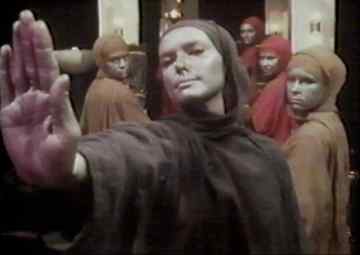 |
Jenna compared the surface of UP-Duel with the effect of a fusion bomb, and given the planet's history she may well have been right.